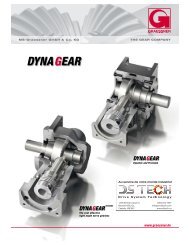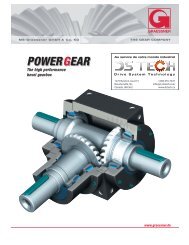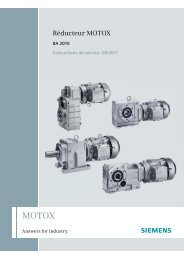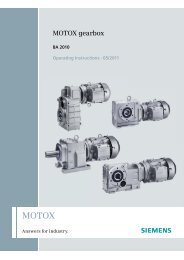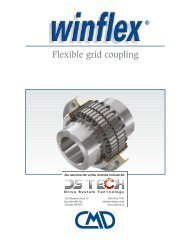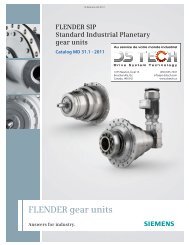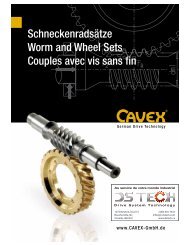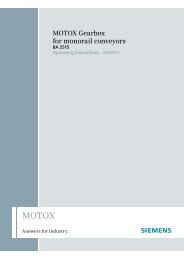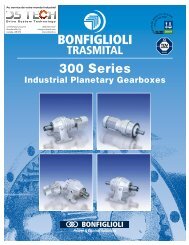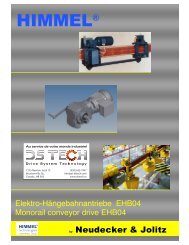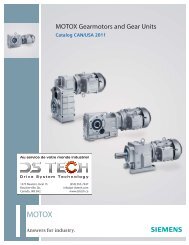FLENDER Standard Couplings - DS TECH
FLENDER Standard Couplings - DS TECH
FLENDER Standard Couplings - DS TECH
- No tags were found...
You also want an ePaper? Increase the reach of your titles
YUMPU automatically turns print PDFs into web optimized ePapers that Google loves.
© Siemens AG 2011<br />
<strong>FLENDER</strong> <strong>Standard</strong> <strong>Couplings</strong><br />
Introduction<br />
The mechanical drive train comprises individual units such as<br />
motor, gear unit and driven machine. The coupling connects<br />
these component assemblies.<br />
As well as the transmission of rotary motion and torque, other requirements<br />
may be made of the coupling.<br />
• Compensation for shaft misalignment with low restorative<br />
forces<br />
• Control of characteristic angular vibration frequency and<br />
damping<br />
• Interruption or limitation of torque<br />
• Noise insulation, electrical insulation<br />
<strong>Couplings</strong> are frequently chosen after the machines to be connected<br />
have already been selected. Thanks to a large number<br />
of different coupling assembly options, specified marginal conditions<br />
for clearance and connection geometry can be met from<br />
the standard range. The coupling also performs secondary<br />
functions, e.g. providing a brake disk or brake drum for operating<br />
or blocking brakes, devices to record speed or the attachment<br />
of sprockets or pulleys.<br />
<strong>Couplings</strong> are divided into two main groups, couplings and<br />
clutches.<br />
Rigid couplings, designed as clamp, flanged or mechanism<br />
couplings, connect machines which must not undergo any shaft<br />
misalignment. Hydrodynamic couplings, often also called fluid<br />
or Föttinger couplings, are used as starting couplings in drives<br />
with high mass moments of inertia of the driven machine. In drive<br />
technology very often flexible, positive couplings, which may be<br />
designed to be torsionally rigid, torsionally flexible or highly<br />
flexible, are used.<br />
Torsionally rigid couplings are designed to be rigid in a peripheral<br />
direction and flexible in radial and axial directions. The<br />
angle of rotation and torque are conducted through the coupling<br />
without a phase shift.<br />
Torsionally flexible couplings have resilient elements usually<br />
manufactured from elastomer materials. Using an elastomer material<br />
with a suitable ShoreA hardness provides the most advantageous<br />
torsional stiffness and damping for the application.<br />
Shaft misalignment causes the resilient elements to deform.<br />
Highly flexible couplings have large-volume (elastomer) resilient<br />
elements of low stiffness. The angle of rotation and torque are<br />
conducted through the coupling with a considerable phase shift.<br />
1<br />
1275 Newton, local 15<br />
Boucherville, Qc,<br />
Canada, J4B 5H2<br />
Clutches interrupt or limited the transmissible torque. The engaging<br />
and disengaging forces on externally operated clutches<br />
are introduced via a mechanically, electrically, hydraulically or<br />
pneumatically operating mechanism. Overload, centrifugal or<br />
freewheel clutches draw their engaging energy from the transmitted<br />
output.<br />
Shaft couplings<br />
<strong>Couplings</strong><br />
Clutches<br />
rigid<br />
flexible<br />
externally<br />
operated<br />
torque-controlled<br />
speed controlled<br />
rotation direction<br />
controlled<br />
Clamp couplings<br />
Flanged couplings<br />
Mechanism couplings<br />
Clutches<br />
Safety couplings<br />
Centrifugal clutches<br />
Freewheel clutches<br />
Overrunning clutches<br />
friction<br />
positive<br />
Hydrodynamic<br />
couplings<br />
Magnetic<br />
couplings<br />
Friction couplings<br />
Torsionally rigid<br />
Torsionally<br />
flexible<br />
Highly flexible<br />
(450) 655-7447<br />
info@pt-dstech.com<br />
www.dstech.ca<br />
Gear couplings<br />
All-steel membrane<br />
couplings<br />
Universal-joint couplings<br />
Parallel-crank couplings<br />
Steel-spring couplings<br />
Pin-and-bush<br />
couplings<br />
Claw couplings<br />
Rubber element<br />
couplings<br />
Rubber-tire<br />
couplings<br />
Rubber-disk<br />
couplings<br />
Rubber spacer ring<br />
couplings<br />
G_MD10_EN_00001<br />
Siemens MD 10.1 · 2011<br />
1/3



